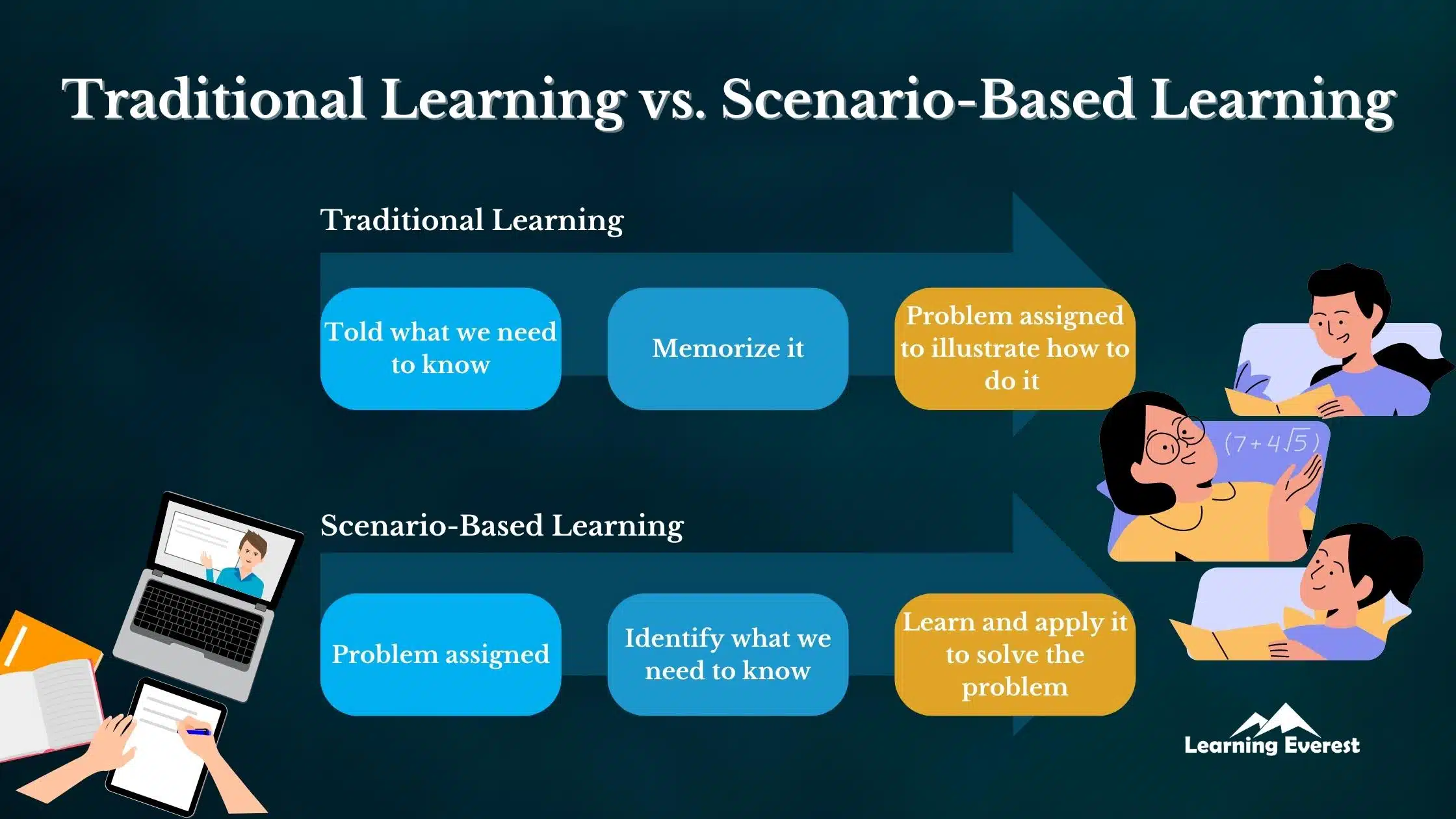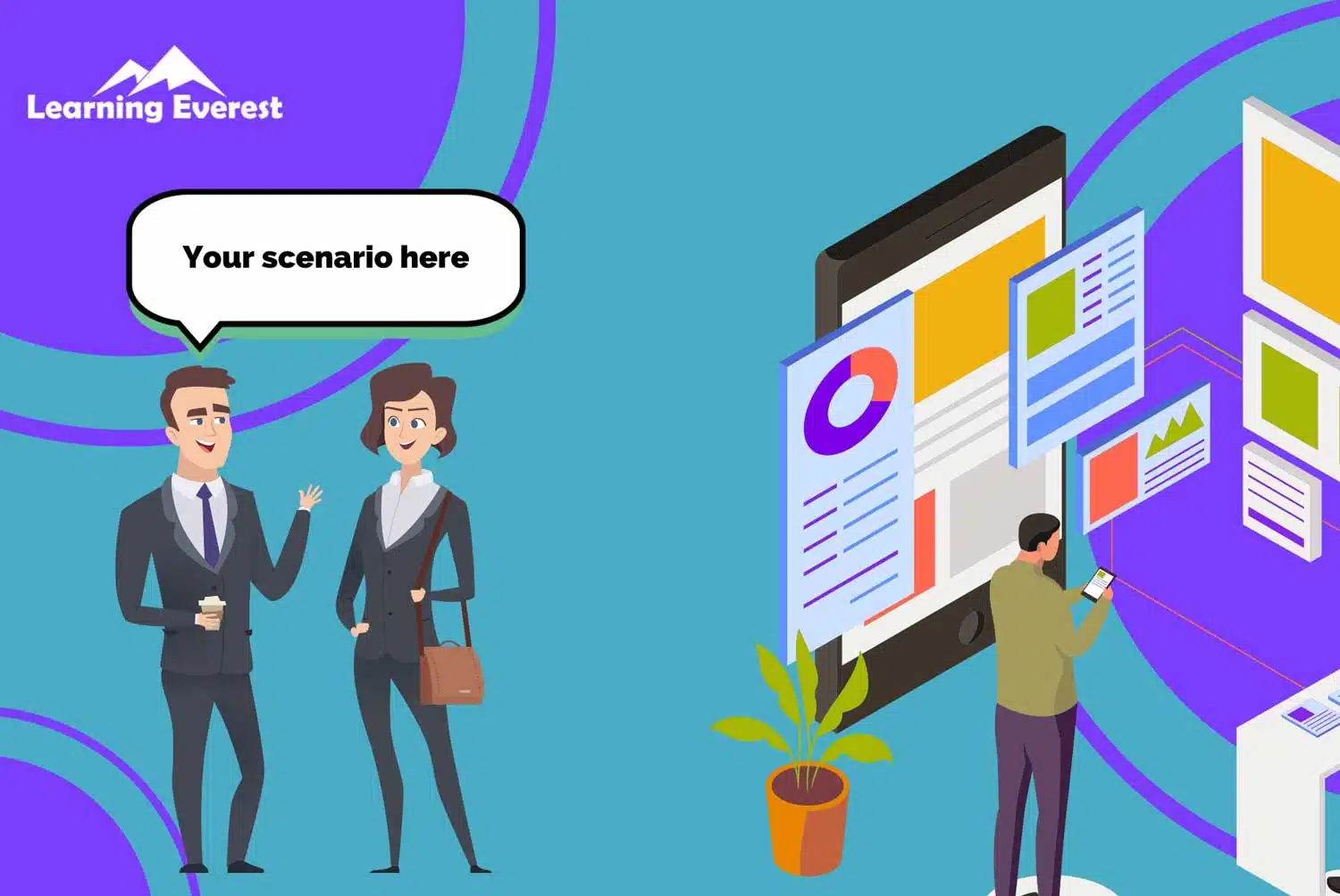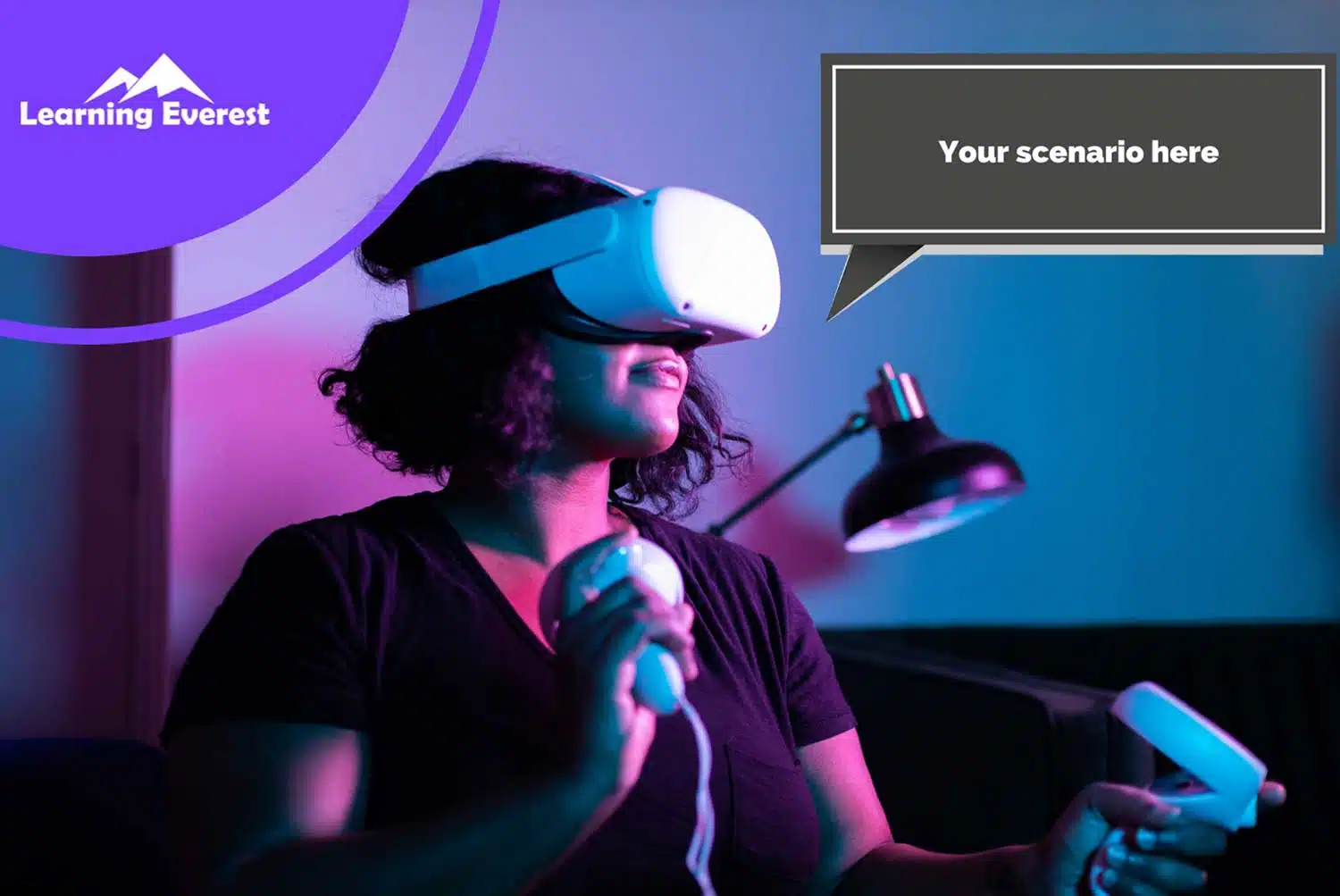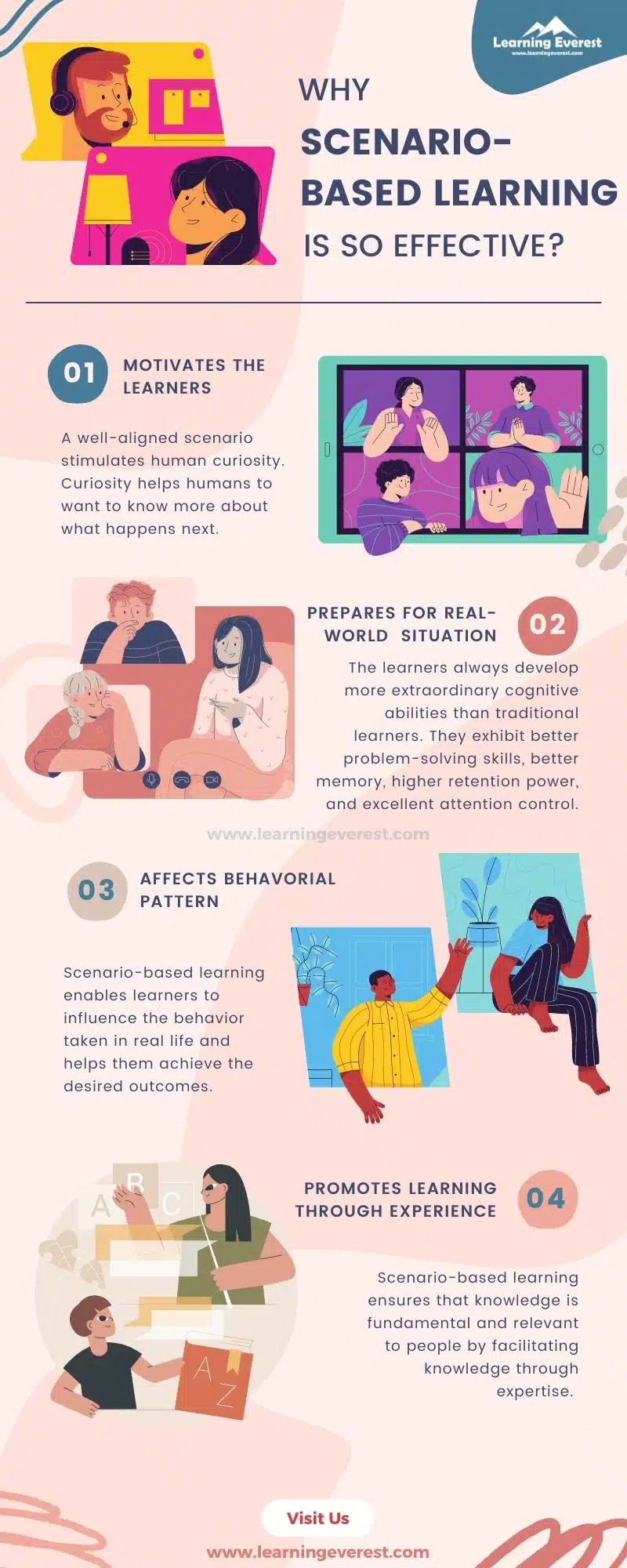Scenario-based learning is a unique approach that can improve e-learning. Scenario-based learning (SBL) provides an immersive training experience where learners meet realistic work challenges and get realistic feedback as they progress since everything that happens reflects the learner’s choices. Instructional designers try to include scenarios in a learning or training module to make it more relatable for the learners.
Table of Contents
- What is scenario-based learning?
- How to create scenario-based learning?
- How is scenario-based learning adding value to e-learning?
- Examples of scenario-based learning
- Infographics
- Knowledge Check!
- Conclusion
- Frequently Asked Questions (FAQs)
- What are scenario-based learning activities?
- What are some examples of scenarios?
- How do you start a scenario?
- What makes a good scenario?
What is scenario-based learning?
In scenario-based learning, the learners are presented with a scenario or a situation and are then asked how to go forward from the scenario. It is a technique of teaching through storytelling. This type of teaching and learning is based on the principles of situated learning theory formulated by Lathe and Vendor in 1991. According to them, learning best takes place in the context in which it is going to be used. Scenario-based learning has a lot in common with Situated cognition. It is the similar idea that knowledge is best acquired and more fully understood when situated within its context.
Scenario-based learning is creating a safe environment where learners can have social interaction during online learning. Scenario-based learning eliminates the lack of personal one-on-one engagement with trained and qualified instructors by providing an interactive environment for active learning.
The goal of this type of learning is to identify a solution or a response to a real-world issue. Scenario-based learning can be used to give compliance training, soft skills training, professional skills training, leadership training, etc.
How to create scenario-based learning?
There are a few requirements to create scenario-based learning.
- To build a scenario, first, we need to collect information about where it takes place, who is there, and what is happening. Knowing the audience helps in creating a relevant situation that helps the learners to use their knowledge in real-world situations.
- When creating a scenario-based e-learning course, always choose scenarios that are non-linear and that often change depending on the learners’ response.
- There should be an overall end conclusion to each scenario. There can be multiple correct endings to a scenario depending on learners’ responses, but they too must be planned, and each path must match the learning objectives of the given course. An effective way to plan endings can be starting with the outcome and then going back to the beginning.
- Make the scenarios as real as possible, so as the images, videos, and interactivities. One can also include resources such as articles from Wikipedia, forums, and social media groups for discussions. Also, e-learning might require to be used in good-old traditional classroom training sometimes, and therefore instructional designers should also consider a blended-learning framework to deliver scenario-based learning.
- Creating real or realistic scenarios that play out well in training or e-learning is not an easy task. The scenarios must force the employees or learners to employ their critical, analytical, and evaluative powers. They must encourage the employees or learners to think creatively and put themselves in the middle of the scenario before taking any action.
- Each scenario-based course should begin with a problem statement. It should generate a sense of crisis. Finding the solution to the problem should be the main motive of scenario-based learning. After the problem statement, the course branches into various ways depending upon the learner’s choices. Instructional designers must provide a detailed outline of what happens in each phase while storyboarding the course.
- Consistency throughout the learning journey is essential. Scenarios should be consistent throughout the course and connect to the real-life application of that course.
- Scenarios should involve the gamification of the work like a challenge. It makes sure the learners are interested throughout the course.
- Take the help of experienced professionals like subject matter experts, managers, team leaders, and other senior members of the organization. Discuss the scenarios with them before implementing them.
Furthermore, because scenario-based learning is a very social and dynamic process, it takes time for it to attain its full potential. As a result, it could take a little longer than normal to develop a scenario that is well-suited to the learner.

Traditional Learning Vs Scenario-based Learning Examples
How is scenario-based learning adding value to e-learning?
Scenario-based learning incorporates storytelling in the e-learning content. It makes the e-learning content which is full of data and information, more engaging and impactful to its learners. It is highly interactive and has a high-fidelity rate due to its nature. It promotes active learning among its learners. It, therefore, enhances the process of solving problems. Here are some ways in which scenario-based learning adds value to a learning journey:
- Motivates the learners: A well-aligned scenario stimulates human curiosity. Curiosity helps humans to want to know more about what happens next. The storytelling nature of scenario-based learning intrigues human psychology. Therefore, naturally, this type of learning generates a sense of motivation in the learners.
- Prepares them for real-world situations: Compared to other traditional learning experiences, scenario-based learning has a higher likelihood of producing successful outcomes. The learners always develop more extraordinary cognitive abilities than traditional learners. They exhibit better problem-solving skills, better memory, higher retention power, and excellent attention control. Employees who need to upskill at their jobs find scenario-based learning more appropriate as it also prepares them to solve real problems.
- Affects the thinking and behavioral patterns: Scenario-based learning enables learners to influence the behavior taken in real life and helps them achieve the desired outcomes. However, scenario-based learning must be well designed, accounting for all the variables in the learner’s real life.
- Better completion rates: Scenario-based learning is exceptional for keeping the learners engaged throughout the learning journey. It cultivates more real experiences from augmented reality than virtual ones.
- Has higher recall and retention power: Visual effects are highly appreciated when it comes to learning. Therefore, by creating audio-visual techniques as a reality, scenario-based learning transforms how learners used to learn and makes it a more easily graspable form of e-learning.
- Promotes learning through experience: Scenario-based learning ensures that knowledge is fundamental and relevant to people by facilitating knowledge through expertise. It generates essential skills such as problem-solving, critical thinking, teamwork, and communication.
Moreover, scenario-based learning is highly engaging and realistic in nature, and the learners are able to relate to the learning process because of that.
Examples of scenario-based learning
Learning and development programs can use scenarios such as:
1. Illustrated dialogue boxes: These scenarios include several dialogues to create an engaging learning experience. Dialogue boxes create a reality of their own to teach the learners or employees. For instance, when providing onboarding training to the new trainee, organizations can conduct a dialogue scene between a new hire and management.

Scenario-based Learning Examples – Illustrated dialogue boxes
2. Real-life scenarios: Instructional designers can choose real-life scenarios to make skill training easy for the employees. It can provide specific skill training. Interesting scenarios provide more fun and experiences to the learners, making the training content more engaging and memorable.

Scenario-based Learning Examples – Real-life scenarios
3. Immersive scenarios: Using games and game methodology embedded within the learning environment, immersive scenario creates experiences in the form of scenarios that are relevant to people.

Scenario-based Learning Examples – Immersive scenarios
Infographics
Knowledge Check!
Conclusion
Scenario-based learning is a model of instructional design. It is changing the way learners used to learn and the way workplace training is used to train employees. Scenario-based learning, while promoting learning through experience, makes the learner ready to face real-world challenges.
Frequently Asked Questions (FAQs)
What are scenario-based learning activities?
In scenario-based learning, the learners are presented with a scenario or a situation and are then asked how to go forward from the scenario. It is a technique of teaching through storytelling.
What are some examples of scenarios?
Real-life scenarios: Instructional designers can choose real-life scenarios to make skill training easy for the employees. It can provide specific skill training. Interesting scenarios provide more fun and experiences to the learners, making the training content more engaging and memorable.
How do you start a scenario?
To build a scenario, first, we need to collect information about where it takes place, who is there, and what is happening. Knowing the audience helps in creating a relevant situation that helps the learners to use their knowledge in real-world situations.
What makes a good scenario?
Each scenario-based course should begin with a problem statement. It should generate a sense of crisis. Finding the solution to the problem should be the main motive of scenario-based learning. After the problem statement, the course branches into various ways depending upon the learner’s choices.






